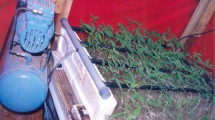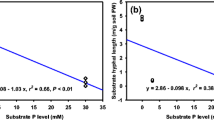Abstract
Groundnuts have a superior ability to take up P from soils with low P fertility compared to sorghum and soybean. Previous experiments showed that this ability was neither attributable to better root development nor to root exudates capable of solubilizing Fe- and Al-bound P, the sparingly soluble P forms in soils. Direct "contact reactions" between cell wall components from these 3 plant species (groundnut, soybean and sorghum) and P-fixing Fe and Al minerals were examined. Cell wall preparations from groundnut roots showed a superior P solubilizing ability than those of soybean and sorghum. Cell wall activity of groundnut roots may thus at least partly explain the superior growth of this crop under P-deficient conditions. To characterize the active site responsible for P solubilization, effects of pH, heat, addition of cations, and digestion with enzymes (pectinase and cellulase) or HCl on P solubilization were investigated. Conclusion are 1) Solubilizing ability is not related to root CEC because soybean with higher root CEC showed an inferior solubilizing ability compared to groundnut. 2) The reaction site of cell-walls of groundnut roots is stable against heating and digestion with cellulase and pectinase. 3) Solubilizing ability was severely reduced by digestion with HCl. 4) Pre-treating cell walls with either Al3+, Fe3+, or Ga3+ decreased solubilizing ability but cations with lower valency such as Na+, K+, Ca2+ or Mg2+ had no effect. Soaking roots of groundnuts grown in solution culture in 0.5 M NaOH for 30 seconds prior to cell wall preparation led to a 30% reduction in solubilization of P from FePO4 without permanently damaging plants. This suggests that 5) the active component of the cell walls was located on the root epidermal cell surfaces. Based on these results a phosphorus solubilizing mechanism is proposed.
Similar content being viewed by others
References
Ae N, Arihara J, Okada K, Yoshihara T and Johansen C 1990 Phosphorus uptake by pigeon pea and its role in cropping systems of the Indian subcontinent. Science 288, 477-480.
Ae N, Otani T, Makino T and Tazawa J 1996 Role of cell wall of groundnut roots in solubilizing sparingly soluble phosphorus in soil. Plant and Soil 186, 197-204.
Arnon D I 1936 Microelements in culture-solution experiments with higher plants. Am. J. Bot. 25, 322-325.
Atkinson R J, Posner A M and Quirk J P 1967 Adsorption of potential-determining irons at the ferric oxide-aqueous electrolyte interface. J. Phys. Chem. 71, 550-558.
Bray R H and Kurtz L T 1945 Determination of total, organic, and available forms of phopshorus in soils. Soil Sci. 59, 30-45.
Hallock D L 1962 Effect of lime and rate of fertilizer application on yield and seed size of jumbo runner peanuts. Agron. J. 54, 428-430.
Ida T, Hori S and Okuda A 1958 Studies on cation absorption by plant roots. I. Cation exchange capacity and cation absorption selectivity of roots. Jpn. J. Soil Sci. Plant Nutr. 29, 25-262 (In Japanese).
Jackson M L, Lim C H and Zelanzny L W 1986 Oxides, hydroxides, and aluminosilicates. InMethods of Soil Analysis. Part 1. Physical and Mineralogical Methods. Ed. A Klute. pp 101-150. Academic Society of Agronomy, Madison, WI, USA.
Jenny H and Overstreet R 1939 Cation interchange between plant roots and soil colloids. Soil Sci. 47, 257-272.
Jungk A 1991 Dynamics of nutrient movement at the soil-root interface. InPlant Roots: The Hidden Half. Ed. A Klute. pp 101-150. American Society of Agronomy, Madison, WI, USA.
Kitson R E and Mellon M G 1944 Colorimetric determination of phopshorus as molybdovanadophosphoric acid. Ind. Eng. Chem. Anal. Ed. 16, 379-383.
Markwalder H U and Neukom H 1976 Diferulic acid as a possible crosslink in hemicelluloses from wheat germ. Phytochemistry 15, 836-837.
Masuda H, Komiyama S and Sugawara S 1989 Cell wall proteins from sugar beet cells in suspension culture. Plant Physiol. 89, 712-716.
Murphy J and Riley J P 1962 A modified single solution method for the determination of phosphate in natural waters. Anal. Chem. Acta 27, 31-36.
Nanzyo M and Watanabe Y 1981 Material balance associated with phosphate sorption by amorphorus clays, silica-alumina gel and synthetic goethite. Soil Sci. Plant Nutr. 29, 329-337.
Otani T and Ae N 1996a Sensitivity of phosphorus uptake to changes in root length and soil volume. Agron. J. 88, 371-375.
Otani T and Ae N 1996b Phosphorus (P) uptake mechanisms of crops grown in soils with low P status. I. Screening crops for efficient P uptake. Soil Sci. Plant Nutr. 42, 155-163.
Otani T, Ae N and Tanaka H 1996 Phosphorus (P) uptake mechanisms of crops grown in soils with low P status. II. Significance of organic acids in root exudates of pigeonpea. Soil Sci. Plant Nutr. 42, 553-560.
Sekiya K 1983 Fractionation of inorganic phosphorus. in Methods of Soil Analysis. Ed. S Ishizawa. pp 235-237. Yokendo, Tokyo, Japan.
Truog E 1930 Determination of the readily available phosphorus of soils. J. Am. Soc. Agron. 22, 874-882.
Author information
Authors and Affiliations
Rights and permissions
About this article
Cite this article
Ae, N., Otani, T. The role of cell wall components from groundnut roots in solubilizing sparingly soluble phosphorus in low fertility soils. Plant and Soil 196, 265–270 (1997). https://doi.org/10.1023/A:1004266411694
Issue Date:
DOI: https://doi.org/10.1023/A:1004266411694




